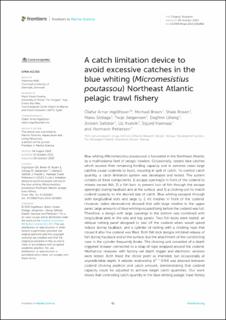| dc.contributor.author | Ingólfsson, Ólafur Arnar | |
| dc.contributor.author | Breen, Michael | |
| dc.contributor.author | Rosen, Shale | |
| dc.contributor.author | Sistiaga, Manu | |
| dc.contributor.author | Jørgensen, Terje | |
| dc.contributor.author | Lilleng, Dagfinn | |
| dc.contributor.author | Saltskår, Jostein | |
| dc.contributor.author | Kvalvik, Liz Beate Kolstad | |
| dc.contributor.author | Hannaas, Sigurd | |
| dc.contributor.author | Pettersen, Hermann | |
| dc.date.accessioned | 2022-11-10T12:13:58Z | |
| dc.date.available | 2022-11-10T12:13:58Z | |
| dc.date.created | 2022-10-31T12:05:06Z | |
| dc.date.issued | 2022 | |
| dc.identifier.citation | Frontiers in Marine Science. 2022, 9 . | |
| dc.identifier.issn | 2296-7745 | |
| dc.identifier.uri | https://hdl.handle.net/11250/3031169 | |
| dc.description.abstract | Blue whiting (Micromesistius poutassou) is harvested in the Northeast Atlantic by a multinational fleet of pelagic trawlers. Occasionally, vessels take catches which exceed their remaining holding capacity and in extreme cases large catches cause codends to burst, resulting in spill of catch. To control catch quantity, a catch limitation system was developed and tested. The system consists of three components: 1) escape opening(s) in front of the codend to release excess fish, 2) a fish lock to prevent loss of fish through the escape opening(s) during haulback and at the surface, and 3) a choking unit to match codend capacity to the desired size of catch. Blue whiting escaped through both longitudinal slots and large (≥ 2 m) meshes in front of the codend. However, video observations showed that with large meshes in the upper panel, large amounts of blue whiting escaped long before the codend was full. Therefore, a design with large openings in the bottom was combined with longitudinal slots in the side and top panels. Two fish locks were tested: an oblique netting panel designed to seal off the codend when vessel speed reduce during haulback, and a cylinder of netting with a choking rope that closed it after the codend was filled. Both fish lock designs inhibited release of fish during haulback and at the surface, but the attachment of the constricting rope in the cylinder frequently broke. The choking unit consisted of a depth triggered releaser connected to a strap of rope wrapped around the codend. Mechanical releasers with factory-set depth trigger and electronic versions were tested. Both freed the choke point as intended, but occasionally at unpredictable depth. A reliable relationship (r2 = 0.94) was attained between codend choking position and catch amount, demonstrating that codend capacity could be adjusted to achieve target catch quantities. Our work shows that controlling catch quantity in the blue whiting pelagic trawl fishery can be achieved effectively through relatively simple modifications to the codend section Future work is needed to optimize the fish lock design and ensure the codend choking rope releasers trigger reliably and at the proper depth. | |
| dc.description.abstract | A catch limitation device to avoid excessive catches in the blue whiting (Micromesistius poutassou) Northeast Atlantic pelagic trawl fishery | |
| dc.language.iso | eng | |
| dc.relation.uri | https://www.frontiersin.org/articles/10.3389/fmars.2022.1011862/full | |
| dc.title | A catch limitation device to avoid excessive catches in the blue whiting (Micromesistius poutassou) Northeast Atlantic pelagic trawl fishery | |
| dc.title.alternative | A catch limitation device to avoid excessive catches in the blue whiting (Micromesistius poutassou) Northeast Atlantic pelagic trawl fishery | |
| dc.type | Peer reviewed | |
| dc.type | Journal article | |
| dc.description.version | publishedVersion | |
| dc.source.pagenumber | 17 | |
| dc.source.volume | 9 | |
| dc.source.journal | Frontiers in Marine Science | |
| dc.identifier.doi | 10.3389/fmars.2022.1011862 | |
| dc.identifier.cristin | 2066715 | |
| dc.relation.project | Fiskeri- og havbruksnæringens forskningsfinansiering: 901542 | |
| cristin.ispublished | true | |
| cristin.fulltext | original | |
| cristin.qualitycode | 1 | |
